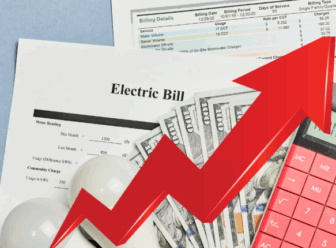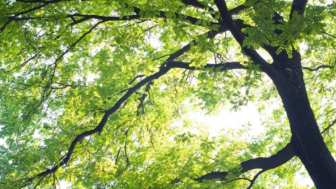The popularity of trees is taking a hit in the land of carbon dioxide equivalents; trees uptake carbon while alive but can be chopped down. It is hard to figure out how much carbon a tree is removing when it is newly planted and has a high chance of mortality. Add to that that fact that some scientists say that the dark color of trees in the North makes it so they absorb the rays of the sun and cancel out the positive effect of absorbing Carbon Dioxide and releasing water vapor (Brahic, C. 2006. Location is key for trees to fight global warming. New Scientist, December 15, 2006. http://environment.newscientist.com/channel/earth/dn10811-location-is-key-for-trees-to-fight-globalwarming.html. [you need a subscription to read this article]). I have friends in forestry and they asked me to share information with them that I find about trees and global warming, so this post is for them.
Let’s talk for a moment about why trees are crucial to protecting us from global warming. Eric Carlson of Carbonfund shared 8/16 (in the comments of the ClimateProgress blog) this food for thought:
But consider this: Trees are the only carbon offset that actually reduce CO2 emissions in the atmosphere today and from the last half century or longer. Renewables and efficiency reduce the need for future emissions (also critical) but trees serve important social and environmental needs, reduce CO2 today and BUY us time to get to a clean tech future. Also, if deforestation accounts for about 20% of climate change, as many experts agree, reforestation is absolutely a part of the solution. And certified offsets are the same whether they come from wind or trees (which is why certifications are so important). Many of our supporters prefer trees and, given their importance, we give them the choice of which type of offsets they want to support. I absolutely understand people who prefer renewables or efficiency, but I also understand why some people would choose trees and they too are providing an important part of the solution.
I would also call your attention to the Forest Service publication, Urban Tree Planting and Greenhouse Gas Reductions, by Greg McPherson:
- Although sequestration rates will level off once an urban tree planting project reaches maturity, the reduced emissions due to energy savings will continue to accrue annually.
- Dead trees can be converted to wood products or used as bioenergy, further delaying, reducing, or avoiding greenhouse gas emissions.
- Tree planting projects provide myriad other social, environmental, and economic benefits that make
communities better places to live.
Regarding uncertainty of the permanence of trees, this article suggests that permanent easements and other land protections should be used in combination with tree plantings. My Forester friends already do this. Oftentimes the landowner can get a tax deduction for the easement, so it is a win-win.
Regarding the reflectivity of the trees, or albedo, the Forest Service makes this eloquent case:
- In cities, the climate effects of incremental darkening from increased tree canopy cover are even less relevant.
- Asphalt, concrete, and roof surfaces account for 50 to 70 percent of urban areas, with the remaining area covered by trees, grass, and bare soil.
- The difference in the albedos of the different urban surfaces is small. Vegetation canopies have albedos of 0.15 to 0.30, the albedo of asphalt is 0.10, that of concrete and buildings is 0.10 to 0.35, and the overall albedo in low-density residential areas is 0.20 (Taha et al. 1988).
- In cities, increasing urban tree canopy cover does not appreciably alter surface reflectance or increase heat trapping.
- A number of field and modeling experiments have found that urban trees reduce summertime air temperatures through evapotranspiration and direct shading (Akbari and Taha 1992, Rosenfeld et al. 1998, McPherson and Simpson 2003). This reduces energy consumption and the emissions related to energy generation.
- Recognizing the climate benefits of trees, the California Climate Action Team report (2006) recommended planting 5 million trees in cities to reduce 3.5 million metric tons of carbon dioxide. Our recent study found that by planting 1 million trees, the Million Trees LA program will reduce atmospheric carbon dioxide by about 1 million tons over the next 35 years, equivalent to taking 7,000 cars off the road each year (McPherson et al. 2007). Since 1990, Trees Forever, an Iowa-based nonprofit organization, has planted trees for energy savings and atmospheric carbon dioxide reduction with utility sponsorships (McPherson et al. 2006). More than 1 million trees have been planted in 400 communities with the help of 120,000 volunteers. These trees are estimated to offset carbon dioxide emissions by 50,000 tons annually.
According to the Society for Ecological Restoration International, in an article from Science Daily yesterday, “”Ecological restoration is a critical tool in addressing global climate change, enhancing the extent and functioning of carbon sinks as well as reducing greenhouse gas emissions…Unless checked, global climate change will destroy people, places, and life as we know it. Ecological restoration offers hope in two key areas:”
- By reconnecting fragmented ecosystems allowing animals and plants to migrate in response to such change;
- By capturing carbon through the restoration of forests, peat-forming wetlands, and other ecosystems that act as carbon sinks,” said George Gann, incoming Chair of SER. “Protecting what we have is still important, but no longer sufficient,” added Jim Harris, SER’s Science and Policy Working Group Chair.
Once you start thinking of trees and other ecological restoration as protecting and restoring the conditions and connectivity of crucial habitat, providing cooling in urban areas, and removing greenhouse gases from the troposphere, you may start to go soft on trees. The lesson here is that trees must be protected from certain kinds of outcomes in order for them to be effective. Think of the alternative to trees and ecological restoration. Is that what we want?
cross-posted at www.local-warming.blogspot.com.




